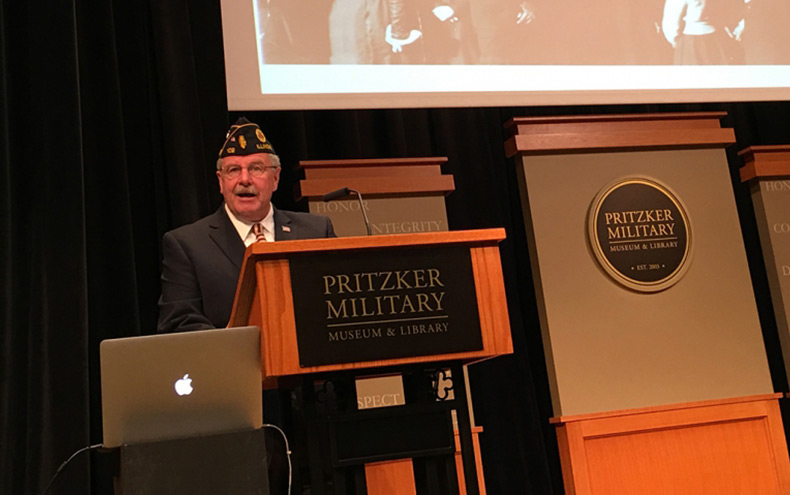
A nationwide project to locate, assess conditions and restore World War I monuments and memorials – many of which were erected by American Legion posts – can “incite a national conversation” about the Great War and its many impacts, says Daniel Dayton, United States World War One Centennial Commission executive director. “We’re three generations out, and we can’t afford to miss this generation.”
Dayton and American Legion Past National Commander Marty Conatser, adjutant for the Legion’s Department of Illinois and its more than 750 local posts, were among the speakers at the Upper Midwest Regional Meeting of the World War One Centennial Commission in September. The Chicago event brought to the Pritzker Military Museum & Library state World War I centennial representatives from across the Midwest, including Deborah York of Tennessee, great-granddaughter of Medal of Honor recipient Alvin York, a first-generation member of The American Legion. Tuesday’s meeting was streamed live online to a nationwide audience.
“If we all work together, we can build a great puzzle,” said York, who lives near Pall Mall, Tenn., home of the Sergeant Alvin C. York State Historic Park, which has undergone numerous renovations and improvements, including construction of an authentic World War I battle trench, frequent battle re-enactments, a visitor center modeled after Sgt. York’s General Store and more. “We can make something really beautiful because we come at this from so many different angles.”
“Honor and remembrance are in the DNA of The American Legion and have been since its founding nearly a century ago,” Conatser told the group. “Through the decades, The American Legion has been the official caretaker and supporter of innumerable memorials and monuments across the land and beyond our shores.”
The American Legion National Executive Committee passed a resolution in May to support and promote the 100 Cities/100 Memorials grant program that offers matching funds of up to $2,000 for projects tor restore World War I monuments and memorials in local communities throughout the United States. To learn more about how to raise funds locally and apply for grants, click here.
The 100 Cities/100 Memorials grant application deadline is July 15, 2017. The Pritzker Military Museum & Library plans to publish a coffee table book to showcase the 100 chosen memorials and monuments by 2018.
“Beyond the matching-money grants that will help many Legion posts restore World War I memorials and monuments, this is an excellent opportunity to build one comprehensive inventory into a database that can be mapped and made accessible online,” Conatser said. “These monuments and memorials are no good to anyone if no one knows where they are and what they express. As years and decades go by, they deteriorate with age and are forgotten – which is not what we want.”
He said the entire American Legion Family can get involved with the effort to find and revive local memorials in honor of the centennial, whether they pursue grant money or not. American Legion Riders chapters, Sons of The American Legion Squadrons, American Legion Auxiliary units, Boy Scout troops attached to posts and others in local communities can work together to locate and take inventory, he said. Conatser advised the centennial representatives to make contact with American Legion department adjutants to spread the word about the effort and to find opportunities to work together as the Legion draws nearer to its 100th anniversary, to be recognized between August 2018 and November 2019.
“Thousands of hometown American Legion posts were named in honor of World War I troops who gave their lives to win peace in Europe,” Conatser said. “The earliest American Legion members were dedicated to the fourth line in the Preamble to our Constitution: ‘to preserve the memories and incidents of our associations in the Great Wars.’”
